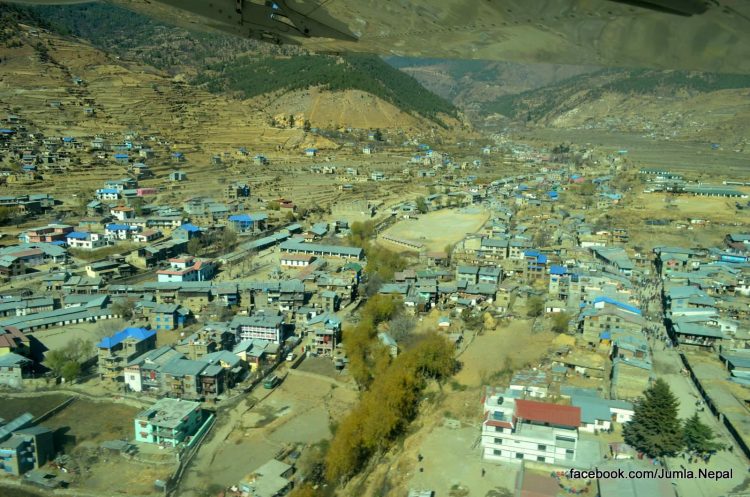Entire Jumla is getting by on less than 1 MW of electricity
Sujit Mainali / June 5, 2018

Chandannath Municipality of Jumla pictured in 2012. Photo: Prashant Shahi/Wikimedia commons
Gajendra Bahadur Mahat, a member of federal parliament representing Jumla district said the following in an interview published on Youtube by Nepali Radio Network on May 31:
We need just one megawatt of electricity. We won the election by promising to arrange one megawatt of electricity for Jumla. For now one megawatt will be enough.
South Asia Check found that Mahat is correct in saying that entire Jumla district does not have even one megawatt of electricity.
According to a report titled “Ten years plan for the development of Karnali region (2016/17-2026/27)” prepared by Karnali Development Commission, micro hydropower projects running in [the erstwhile] 18 village development committees of Jumla are generating a total of 526 kilowatts of electricity. At present, Nepal is generating a total of 1073 MW of electricity while another 450 MW is imported from India.
Jumla cannot use the electricity generated elsewhere because the district is not connected to the national grid. Therefore the district is getting by on the 526 kilowatts electricity, which is 474 kilowatts less than one megawatt.
According to the Commission’s report, 44 percent households in the district use solar power to light their houses while 29 percent use hydropower for the purpose. Likewise, 99 percent households use firewood for cooking. Forty-two percent households own radio sets, 11 percent own television sets and 46 percent own cell phones. Altogether 621 households in the district have landline telephone, but only 68 households have internet, the report says.
Jumla is among the most backward districts of Nepal in terms of human development. The district’s HDI value for 2014 was 0.409. However it is not the most backward district of Nepal. The HDI values for districts like Bajura, Bajhang, Kalikot, Humla, Achham, Rautahat, Mahottari, Jajarkot, Rolpa, Mugu, Dolpa, Sarlahi, Doti and Siraha are even lower than that of Jumla.
This material is copyrighted but may be used for any purpose by giving due credit to southasiacheck.org.
Comments
Latest Stories
- In Public Interest Covid-19 cases are low, but that’s not an excuse to avoid vaccination
- In Public Interest What is BF.7, the sub-variant that has the world by its grip?
- In Public Interest Threat of a new Covid-19 wave looms large amid vaccine shortage in Nepal
- In Public Interest As cases decline, Covid-19 test centres in Kathmandu are desolate lot
- In Public Interest Dengue test fee disparity has patients wondering if they’re being cheated
- In Public Interest As dengue rages on, confusion galore about what it is and what its symptoms are. Here’s what you need to know
In Public Interest
 Covid-19 cases are low, but that’s not an excuse to avoid vaccination
The Pfizer-BioNTech bivalent vaccines authorised by the Nepal Government provide better protection a...
Read More
Covid-19 cases are low, but that’s not an excuse to avoid vaccination
The Pfizer-BioNTech bivalent vaccines authorised by the Nepal Government provide better protection a...
Read More
- What is BF.7, the sub-variant that has the world by its grip?
- Threat of a new Covid-19 wave looms large amid vaccine shortage in Nepal
- As cases decline, Covid-19 test centres in Kathmandu are desolate lot
- Dengue test fee disparity has patients wondering if they’re being cheated
- As dengue rages on, confusion galore about what it is and what its symptoms are. Here’s what you need to know